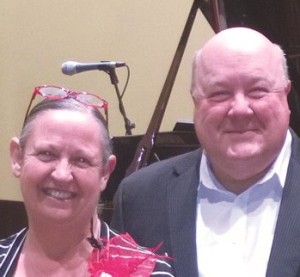
 Vickie Oliver, Groveport, OH — Teaching our children is such an important ministry and requires us to give our very best. I like to involve the children’s senses of sight, touch, hearing, and even smell when presenting a lesson. We must be creative and use methods that will keep their attention. I personally love object lessons and storytelling. After we’ve prepared a lesson, nothing is more important than creating an atmosphere for Jesus to move. Teach them to pray and help them connect with Jesus right there in the room.
Vickie Oliver, Groveport, OH — Teaching our children is such an important ministry and requires us to give our very best. I like to involve the children’s senses of sight, touch, hearing, and even smell when presenting a lesson. We must be creative and use methods that will keep their attention. I personally love object lessons and storytelling. After we’ve prepared a lesson, nothing is more important than creating an atmosphere for Jesus to move. Teach them to pray and help them connect with Jesus right there in the room.

Phil Wagoner, Paris, IL — Prayer is the most important thing because I believe that if you are going to be in a position like this, then you need to be prepared. Prayer will help you head in the right direction and be able to perform in the way that God would want you to perform. God has given each and every one a talent, and you need to use that talent to be able to reach that child’s soul. Don’t try to do anything that you are not comfortable with but if you like something, practice makes perfect. I like to incorporate a lot of science and object lessons. I always try to dress up and act like I’m a part of what I’m trying to teach and be. Don’t wait until the last minute and throw everything together. Make sure you are prepared and have a grasp on your material.

Tim Rimmer, Murfreesboro, TN — Be creative, bring the lesson to life. The children can interact and memories will be forever etched in their hearts. Build props, costumes or visuals that would allow the children to participate in the lesson; this will make a lasting impression on a child. My favorite method of teaching a lesson are object lessons, taking everyday household items, chemical reactions, the possibilities are endless. The goals of illustrating lessons are to help children visualize the Word of God for themselves. Never put a child in danger or force a child to participate as one never knows the inner fears; nor should a child be embarrassed. It’s okay to add humor but not at a child’s expense, especially if it degrades or humiliates the child. Make the lesson exciting; if the teacher is excited then the children will respond the same.
 Mike Easter, Newport News, VA — Come up with a creative idea that’s out of the norm. Be creative and think out of the box; things like that the children will remember. My favorite method of giving a lesson is by telling the story using illustrations, things that they can actually see. I don’t do a lot of reading to them. I study the material and dramatize the story to the child, which captures their imagination and keeps their focus. Be sure to be enthusiastic! The student is only going to be interested if the teacher is interested. If the lesson becomes a routine, find new ways to make it interesting for you and the students.
Mike Easter, Newport News, VA — Come up with a creative idea that’s out of the norm. Be creative and think out of the box; things like that the children will remember. My favorite method of giving a lesson is by telling the story using illustrations, things that they can actually see. I don’t do a lot of reading to them. I study the material and dramatize the story to the child, which captures their imagination and keeps their focus. Be sure to be enthusiastic! The student is only going to be interested if the teacher is interested. If the lesson becomes a routine, find new ways to make it interesting for you and the students.
 Dennis Ploch, Olive Branch, MS — Really, one of the basic ways to make something a lasting memory is to have an emotional impact. This works whether you can make an emotional impact with a student or relay an impact you’ve had on your life. Some kind of emotional impact will relay the scripture to the children and let them know it is real. What I like to do to illustrate a lesson is to have someone dress up like the character you are talking about in the scriptures and have them come into the room and present the lesson on a first person basis. Also, don’t spend too much time on one thing; break your lesson up to keep the students interested.
Dennis Ploch, Olive Branch, MS — Really, one of the basic ways to make something a lasting memory is to have an emotional impact. This works whether you can make an emotional impact with a student or relay an impact you’ve had on your life. Some kind of emotional impact will relay the scripture to the children and let them know it is real. What I like to do to illustrate a lesson is to have someone dress up like the character you are talking about in the scriptures and have them come into the room and present the lesson on a first person basis. Also, don’t spend too much time on one thing; break your lesson up to keep the students interested.
 Brent Randall, Stockton, CA — I like to allow the students to act out the various sound effects and the body motions in the story with you. If you have a story with a lot of action in it, a lot of noise, a lot of sound, let the audience mimic all of that with you. I do different voices for the different characters in the story allowing the audience to act out the story with me. They will retain it better because they didn’t just hear the story, they did the story. Get rid of any barriers between you and them. Engage the audience and connect with them. Don’t just read your content, you’ll lose your audience; make sure to connect with them.
Brent Randall, Stockton, CA — I like to allow the students to act out the various sound effects and the body motions in the story with you. If you have a story with a lot of action in it, a lot of noise, a lot of sound, let the audience mimic all of that with you. I do different voices for the different characters in the story allowing the audience to act out the story with me. They will retain it better because they didn’t just hear the story, they did the story. Get rid of any barriers between you and them. Engage the audience and connect with them. Don’t just read your content, you’ll lose your audience; make sure to connect with them.
 Gary Randol, Moline, IL — It is important that a teacher do more than just verbally communicate a lesson. They must make it come alive to the students, by using various techniques: tell them, show them, let them experience it, and even make time for discussion to make sure they have a lasting memory. We must be willing to think outside the box, to think as a child would and not as an adult. There are so many creative ways to illustrate a lesson and each of them can be powerful in portraying a lesson. You can teach in more ways than just verbal. An effective way to keep their attention is to create your lesson plan in such a way as to provide plenty of variety.
Gary Randol, Moline, IL — It is important that a teacher do more than just verbally communicate a lesson. They must make it come alive to the students, by using various techniques: tell them, show them, let them experience it, and even make time for discussion to make sure they have a lasting memory. We must be willing to think outside the box, to think as a child would and not as an adult. There are so many creative ways to illustrate a lesson and each of them can be powerful in portraying a lesson. You can teach in more ways than just verbal. An effective way to keep their attention is to create your lesson plan in such a way as to provide plenty of variety.
 David Reynolds, Lyle, WA — The most important thing to have as the teacher enters her classroom is a well-defined “teaching objective.” This is not the story- the story is just the means to convey the truth to be taught. Everything said or done in the lesson must focus on the lesson objective. To do this, the teacher must spend hours in prayer and preparation. They have to know their students, the level that they are on, the needs of the student, and try to meet the needs of the student. Use the methods that Jesus used to illustrate a lesson; He used illustrations, stories, questionings and objects; don’t use the same thing all the time. But the method must be the method that the students need.
David Reynolds, Lyle, WA — The most important thing to have as the teacher enters her classroom is a well-defined “teaching objective.” This is not the story- the story is just the means to convey the truth to be taught. Everything said or done in the lesson must focus on the lesson objective. To do this, the teacher must spend hours in prayer and preparation. They have to know their students, the level that they are on, the needs of the student, and try to meet the needs of the student. Use the methods that Jesus used to illustrate a lesson; He used illustrations, stories, questionings and objects; don’t use the same thing all the time. But the method must be the method that the students need.
Interviews by Alexis Sims

